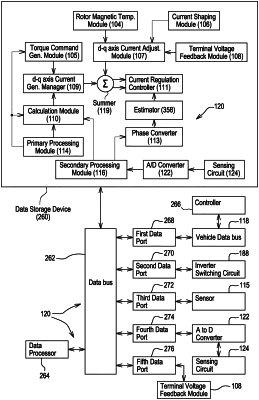| CPC B60L 53/20 (2019.02) [B60L 15/20 (2013.01); H02P 21/05 (2013.01)] | 24 Claims |

|
1. An inverter system for mitigating oscillation of a rotary system that drives a generator, the rotary system comprising a driveshaft or shaft of a vehicle that is mechanically rotationally coupled to generator, the inverter system further comprising:
a torque command generation module for receiving an observed torque or commanded torque from an operator of a vehicle that applies rotational energy to the shaft;
a torque damping module for detecting the commanded torque applied to a rotor of a generator and generating a commanded compensating torque to dampen any mechanical oscillation or resonance of the generator and the rotary system based on the observed rotational speed of the generator; wherein in the torque damping module further comprises:
a filter of order greater than one, wherein the filter has a bandpass or high-pass filter response of magnitude versus frequency, wherein the input to the filter comprises the observed rotational speed of the generator and wherein the output of the filter comprises an isolated oscillation or ripple of the observed rotational speed with a removed or attenuated DC offset in the compensating torque;
a gain adjuster coupled to the output of the filter, the gain adjuster configured to determine a gain of the commanded compensating torque based on the isolated oscillation or ripple of the observed rotational speed; and
a limiter for restricting the gain to a lower limit of the gain and an upper limit of the gain based on integration of the ripple of the observed rotational speed or proportional integral control of the ripple component of the observed speed.
|